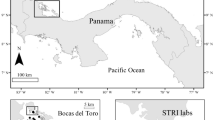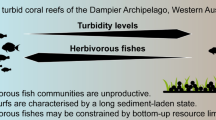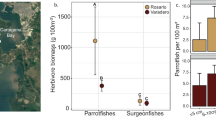Abstract
Herbivores greatly influence the productivity of algae but their impact can depend on the nuances of the timing, location, and intensity of herbivory. While plants can escape herbivory in spatial refugia, small-scale variations in habitat quality play a critical role in plant tolerance to herbivory and might generate complex trade-offs. On coral reefs, overstory branching corals provide a refuge from fish herbivory but also provide refugia for many small fish that excrete nutrients. Therefore, algae living in this habitat might also benefit from higher nutrient delivery. However, because coral branches occlude sunlight, algal growth rates might be impaired despite experiencing elevated nutrients and lower herbivory. In lab-based experiments, light, nutrients, and simulated herbivory were manipulated in summer and winter to investigate how these processes interact to influence the tolerance of herbivory in the calcifying green algae Halimeda, an important producer of reef carbonate sediments worldwide. Halimeda heteromorpha which is commonly found associated with branching corals tolerated tissue damage by increasing rates of segment production. Greater tolerance was observed at levels of light resembling those experienced under the coral’s canopy. Nutrient additions increased compensatory segment growth in winter but not summer. Levels of tolerance were seasonal and nutrient dependent. Results show that small-scale variations in habitat quality may influence tolerance to herbivory in Halimeda. This suggests that if coral habitats are degraded or lost and oceans continue to warm, a likely negative impact on Halimeda populations and its contribution to carbonate sediments could be expected if high levels of herbivory are maintained.




Similar content being viewed by others
References
Armitage AR, Fourqurean JW (2009) Stable isotopes reveal complex changes in trophic relationships following nutrient addition in a coastal marine ecosystem. Estuaries Coasts 32:1152–1164
Ateweberhan M, Bruggemann JH, Breeman AM (2006) Effects of extreme seasonality on community structure and functional group dynamics of coral reef algae in the southern Red Sea (Eritrea). Coral Reefs 25:391–406. doi:10.1007/s00338-006-0109-6
Ballesteros E (1991) Seasonality of growth and production of a deep-water population of Halimeda tuna (Chlorophyceae, Caulerpales) in the North-western Mediterranean. Bot Mar 34:291–302
Beer S, Vilenkin B, Weil A, Veste M, Susel L, Eshel A (1998) Measuring photosynthetic rates in seagrasses by pulse amplitude modulated (PAM) fluorometry. Mar Ecol Prog Ser 174:293–300
Bennett S, Vergés A, Bellwood D (2010) Branching coral as a macroalgal refuge in a marginal coral reef system. Coral Reefs 29:471–480
Borowitzka MA, Larkum AWD (1977) Calcification in the green alga Halimeda: I. an ultrastructure study of thallus development. J Phycol 13:6–16. doi:10.1111/j.1529-8817.1977.tb02879.x
Carpenter RC, Williams SL (1993) Effects of algal turf canopy height and microscale substratum topography on profiles of flow speed in a coral forereef environment. Limnol Oceanogr 38:687–694. doi:10.4319/lo.1993.38.3.0687
Castro-Sanguino C, Lovelock C, Mumby PJ (2016) The effect of structurally complex corals and herbivory on the dynamics of Halimeda. Coral Reefs 35:597–609. doi:10.1007/s00338-016-1412-5
Chazdon RL (1988) Sunflecks and their importance to forest understorey plants. Adv Ecol Res 18:1–63
Cronin G, Hay ME (1996) Effects of light and nutrient availability on the growth, secondary chemistry, and resistance to herbivory of two brown seaweeds. Oikos 77:93–106. doi:10.2307/3545589
Diaz-Pulido G et al (2007) Vulnerability of macroalgae of the Great Barrier Reef to climate change. In: Johnson JE, Marshall PA (eds). Climate change and the Great Barrier Reef. Great Barrier Reef Marine Park Authority & Australian Greenhouse Office, Townsville, pp 153–192
Drew EA (1983) Halimeda biomass, growth rates and sediment generation on reefs in the central Great Barrier Reef Province. Coral Reefs 2:101–110. doi:10.1007/bf02395280
Drew EA, Abel KM (1988) Studies on Halimeda. II. Reproduction, particularly the seasonality of gametangia formation, in a number of species from the Great Barrier Reef Province. Coral Reefs 6:207–218
Ferrari R, Gonzalez-Rivero M, Ortiz JC, Mumby PJ (2012) Interaction of herbivory and seasonality on the dynamics of Caribbean macroalgae. Coral Reefs 31:683–692
Gao X, Endo H, Yamana M, Taniguchi K, Agatsuma Y (2013) Compensatory abilities depending on seasonal timing of thallus excision of the kelp Undaria pinnatifida cultivated in Matsushima Bay, northern Japan. J Appl Phycol 25:1331–1340. doi:10.1007/s10811-013-9989-3
Hay ME (1981) The functional morphology of turf-forming seaweeds: persistence in stressful marine habitats. Ecology 62:739–750
Hay ME, Kappel QE, Fenical W (1994) Synergisms in plant defenses against herbivores: interactions of chemistry, calcification, and plant quality. Ecology 1714–1726
Hay KB, Poore AG, Lovelock CE (2011) The effects of nutrient availability on tolerance to herbivory in a brown seaweed. J Ecol 99:1540–1550
Hillis-Colinvaux L (1980) Ecology and taxonomy of Halimeda: Primary producer of coral reefs. Adv Mar Biol 17:1–327
Honkanen T, Jormalainen V (2002) Within-alga integration and compensation: effects of simulated herbivory on growth and reproduction of the brown alga, Fucus vesiculosus. Int J Plant Sci 163:815–823. doi:10.1086/342081
Hothorn T, Bretz F, Westfall P, Heiberger RM (2008) Multcomp: simultaneous inference in general parametric models. R package version 1.0
Hudson JH (1985) Growth rate and carbonate production in Halimeda opuntia: Marquesas Keys, Florida. In: Toomey DF, Nitecki MH (eds) Paleoalgology: contemporary research and applications. Springer-Verlag, Berlin, pp 257–263
Kaniewska P, Anthony KR, Hoegh-Guldberg O (2008) Variation in colony geometry modulates internal light levels in branching corals, Acropora humilis and Stylophora pistillata. Mar Biol 155:649–660
Kerr JNQ, Paul VJ (1995) Animal-plant defense association: the soft coral Sinularia sp. (Cnidaria, Alcyonacea) protects Halimeda spp. from herbivory. J Exp Mar Biol Ecol 186:183–205
Kraft GT (2007) Algae of Australia: Marine benthic algae of Lord Howe Island and the Southern Great Barrier Reef. 1. Green Algae. CSIRO publishing, Melbourne
Krall J, Edwards G (1990) Quantum yields of photosystem II electron transport and carbon dioxide fixation in C4 plants. Funct Plant Biol 17:579–588. doi:10.1071/PP9900579
Kuznetsova A, Brockhoff PB, Christensen RHB (2012) lmerTest: tests in linear mixed effects models. R package version 1.0
Lapointe BE, Littler MM, Littler DS (1987) A comparison of nutrient-limited productivity in macroalgae from a Caribbean barrier reef and from a mangrove ecosystem. Aquat Bot 28:243–255
Littler MM, Littler DS (1990) Productivity and nutrient relationships in psammophytic versus epilithic forms of Bryopsidales (Chlorophyta): comparisons based on a short-term physiological assay. Hydrobiologia 204:49–55
Littler MM, Littler DS, Lapointe BE (1988) A comparison of nutrient-and light-limited photosynthesis in psammophytic versus epilithic forms of Halimeda (Caulerpales, Halimedaceae) from the Bahamas. Coral Reefs 6:219–225
Lowell RB, Markham JH, Mann KH (1991) Herbivore-like damage induces increased strength and toughness in a seaweed. Proc R Soc Lond B 243:31–38 doi:10.1098/rspb.1991.0006
Mantyka CS, Bellwood DR (2007) Macroalgal grazing selectivity among herbivorous coral reef fishes. Mar Ecol Prog Ser 352:177–185
Maschinski J, Whitham TG (1989) The continuum of plant responses to herbivory: the influence of plant association, nutrient availability, and timing. Am Nat 134:1–19. doi:10.2307/2462272
Mason BM (2009) The importance of detritus and microenvironment nutrient enrichment to the growth of coral reef macroalgae, Halimeda and Dictyota. Master of Science Thesis. University of North Carolina at Wilmington
Mayakun J, Kimb JH, Lapointec BE, Prathepa A (2012) The effects of herbivore exclusion and nutrient enrichment on growth and reproduction of Halimeda macroloba. Sci Asia 38:227–234
Mejia AY, Puncher GN, Engelen AH (2012) Macroalgae in tropical marine coastal systems. In: Wiencke C, Bischof K (eds) Seaweed Biology. Novel insights into ecophysiology, ecology and utilization, vol Part III. vol Ecological studies. Springer, Berlin Heidelberg, pp 329–357
Moran KL, Bjorndal KA (2005) Simulated green turtle grazing affects structure and productivity of seagrass pastures. Mar Ecol Prog Ser 305:235–247
Multer HG (1988) Growth rate, ultrastructure and sediment contribution of Halimeda incrassata and Halimeda monile, Nonsuch and Falmouth Bays, Antigua, WI. Coral Reefs 6:179–186
Nelson WA (2009) Calcified macroalgae-critical to coastal ecosystems and vulnerable to change: a review. Mar Freshwater Res 60:787–801
Paul VJ, Fenical W (1983) Isolation of Halimedatrial: chemical defense adaptation in the calcareous reef-building alga Halimeda. Science 221:747
Paul VJ, Van Alstyne KL (1988) Chemical defense and chemical variation in some tropical Pacific species of Halimeda (Halimedaceae; Chlorophyta). Coral Reefs 6:263–269. doi:10.1007/bf00302022
Paul VJ, Van Alstyne KL (1992) Activation of chemical defenses in the tropical green algae Halimeda spp. J Exp Mar Biol Ecol 160:191–203
Polunin NVC, Koike I (1987) Temporal focusing of nitrogen release by a periodically feeding herbivorous reef fish. J Exp Mar Biol Ecol 111:285–296. doi:10.1016/0022-0981(87)90034-7
Poore AGB et al (2012) Global patterns in the impact of marine herbivores on benthic primary producers. Ecol Lett 15:912–922. doi:10.1111/j.1461-0248.2012.01804.x
Poore AGB, Gutow L, Pantoja J F, Tala F, Jofré Madariaga D, Thiel M (2014) Major consequences of minor damage: impacts of small grazers on fast-growing kelps. Oecologia 174:789–801. doi:10.1007/s00442-013-2795-4
R Development Core Team (2010) R: A language and environment fot statistical computing. R Foundation for Statistical Computing, Vienna
Sagert S, Schubert H (2000) Acclimation of Palmaria palmata (Rhodophyta) to light intensity: comparison between artificial and natural light fields. J Phycol 36:1119–1128
Smith JS, Johnson CR (1995) Nutrient inputs from seabirds and humans on a populated coral cay. Mar Ecol Prog Ser 124:189–200
Smith JE, Smith CM, Vroom PS, Beach KL, Miller S (2004) Nutrient and growth dynamics of Halimeda tuna on Conch Reef, Florida Keys: Possible influence of internal tides on nutrient status and physiology Limnol Oceanogr:1923–1936
Strauss SY, Agrawal AA (1999) The ecology and evolution of plant tolerance to herbivory. Trends Ecol Evol 14:179–185
Sultan SE (2000) Phenotypic plasticity for plant development, function and life history. Trends Plant Sci 5:537–542. doi:10.1016/S1360-1385(00)01797-0
Teichberg M, Fricke A, Bischof K (2013) Increased physiological performance of the calcifying green macroalga Halimeda opuntia in response to experimental nutrient enrichment on a Caribbean coral reef. Aquat Bot 104:25–33. doi:10.1016/j.aquabot.2012.09.010
Thimijan RW, Heins RD (1983) Photometric, radiometric, and quantum light units of measure: a review of procedures for interconversion. HortScience 18:818–822
Tiffin P (2000) Mechanisms of tolerance to herbivore damage: what do we know? Evol Ecol 14:523–536
Tiffin P (2002) Competition and time of damage affect the pattern of selection acting on plant defense against herbivores. Ecology 83:1981–1990
Vergés A, Pérez M, Alcoverro T, Romero J (2008) Compensation and resistance to herbivory in seagrasses: induced responses to simulated consumption by fish. Oecologia 155:751–760
Vergés A, Vanderklift MA, Doropoulos C, Hyndes GA (2011) Spatial patterns in herbivory on a coral reef are influenced by structural complexity but not by algal traits. PloS One 6:e17115
Vroom PS, Smith CM, Coyer JA, Walters LJ, Hunter CL, Beach KS, Smith JE (2003) Field biology of Halimeda tuna (Bryopsidales, Chlorophyta) across a depth gradient: Comparative growth, survivorship, recruitment, and reproduction. Hydrobiologia 501:149–166. doi:10.1023/a:1026287816324
Vuki VC, Price IR (1994) Seasonal changes in the Sargassum populations on a fringing coral reef, Magnetic Island, Great barrier reef region, Australia. Aquat Bot 48:153–166. doi:10.1016/0304-3770(94)90082-5
Wise MJ, Abrahamson WG (2005) Beyond the compensatory continuum: Environmental resource levels and plant tolerance of herbivory. Oikos 109:417–428. doi:10.1111/j.0030-1299.2005.13878.x
Yñiguez AT (2007) Spatial dynamics in the growth and spread of Halimeda and Dictyota in Florida reefs: a simulation modeling approach. PhD dissertation, University of Miami, Florida
Yñiguez AT, McManus JW, Collado-Vides L (2010) Capturing the dynamics in benthic structures: Environmental effects on morphology in the macroalgal genera Halimeda and Dictyota. Mar Ecol Prog Ser 411:17–32. doi:10.3354/meps08643
Acknowledgements
We thank the Heron Island Research Station (HIRS) and the Australian Coral Reef Society for funding to C.C.S and an Australian Research Council Laureate Fellowship to P.J.M. Special thanks to C. Birrell for setting up the flume system, field assistants H. Bravo, M. Briand, D. Jackson, A. Chai and G. Bernal and to the staff of HIRS, CRE, J.C. Ortiz, Y-M. Bozec, C. Doropoulos, G. Roff, and MSEL colleagues for their helpful advice. We also thank S. Blomberg for his invaluable advice on statistics.
Author information
Authors and Affiliations
Corresponding author
Ethics declarations
Conflict of interest
The authors have declared that no competing interests exist.
Ethical approval
This research does not contain any studies with human participants or animals performed by any of the authors. Research was conducted under GBRMPA permit #G13/36037.1.
Additional information
Responsible Editor: K. Bischof.
Reviewed by Undisclosed experts.
Electronic supplementary material
Below is the link to the electronic supplementary material.
Rights and permissions
About this article
Cite this article
Castro-Sanguino, C., Lovelock, C. & Mumby, P.J. Factors affecting tolerance to herbivory in a calcifying alga on coral reefs. Mar Biol 164, 37 (2017). https://doi.org/10.1007/s00227-016-3062-0
Received:
Accepted:
Published:
DOI: https://doi.org/10.1007/s00227-016-3062-0




